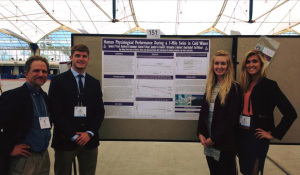
Pictured are from Left to Right: Ted Wilson, Spencer Treu, Mariah Olson and Katelyn Cummings
Students and faculty from Winona State University’s Biology and Math & Statistics departments have recently forged an icy relationship with fellow researchers in South Africa.
Literally.
The WSU group studied data from the International Ice Swimming Association’s website in order to better understand human physiological performance during ice swimming. Data were uploaded by ice swimmers from around the globe, according to WSU biology professor Ted Wilson.
Ram Barkai, founder of the association in Cape Town, South Africa, created the concept of competitive ice swimming and helped guide the WSU students through understanding the association’s swim database.
These competitive swimming events are completed in one mile or one kilometer instances and have to be done in water that is five degrees Celsius or lower. The sport has been considered for the Winter Olympics, and a demonstration was done at the 2014 Sochi Olympics.
According to Wilson, surprisingly few studies have looked at how ice swimming affects the human body, especially considering the threat of hypothermia for recreational or survival swimmers.
“A lot of studies were done on cold water exposure back in World War II,” Wilson said. “But there’s not a lot of accessible data on this.”
Statistics students and Christopher Malone, professor of mathematics & statistics, ran analysis of the data obtained from the website, which allowed the biology students to interpret the data and what that could mean for the athletes.
The students found that age does not have significant impact on the capabilities of the swimmer when it comes to the one-mile races, concluding that an athlete could have a 20-plus-year career in ice swimming. However, age and sex are more important for predicting race times for completing one-kilometer distances, and race times for women decreased at a more significant rate than men over the years.
With help from WSU’s Office of Academic Affairs, the students presented their findings at the Experimental Biology conference in San Diego, where Wilson said the group received encouragement and feedback for their work, including interest from the U.S. Navy.
WSU senior Spencer Treu, who participated in the study as part of his capstone project as a cell and molecular biology major, said he has observed the positive impacts of the international project on him and his classmates.
“I think the biggest thing is everyone on the project grew,” Treu said. “It was the first time I did any research on my own.”
Wilson said the research and positive feedback was a great experience for the students and a confidence builder. As a result of the project, two of the students are now working at the Mayo Clinic as a stepping stone to becoming doctors.
“It was a cool project,” Wilson said. “We’re hoping to have a follow up.”
The group started to collect heart monitors and were working toward creating their own experiment in Winona’s own icy waters last winter, but the company they were purchasing their heart monitors from went bankrupt and closed. But Wilson hasn’t given up hope for a new project.
Treu is also working with the students who are taking over the project with hopes of gathering more data on BMI impacts and to help with the push to get the sport into the Olympics.
With interest from local ice swimming enthusiast Carew Halleck, Wilson is hoping the students can continue their research and development by actually observing and collecting their own data.
If they can find the help, Treu believes the research will provide a huge benefit for the students.
“You only get so much exposure with classroom examples,” Treu said. “I think it’s genuinely incredible that a research opportunity can open up. I don’t think we are limited at WSU.”
For more information, contact Wilson at twilson@winona.edu.
